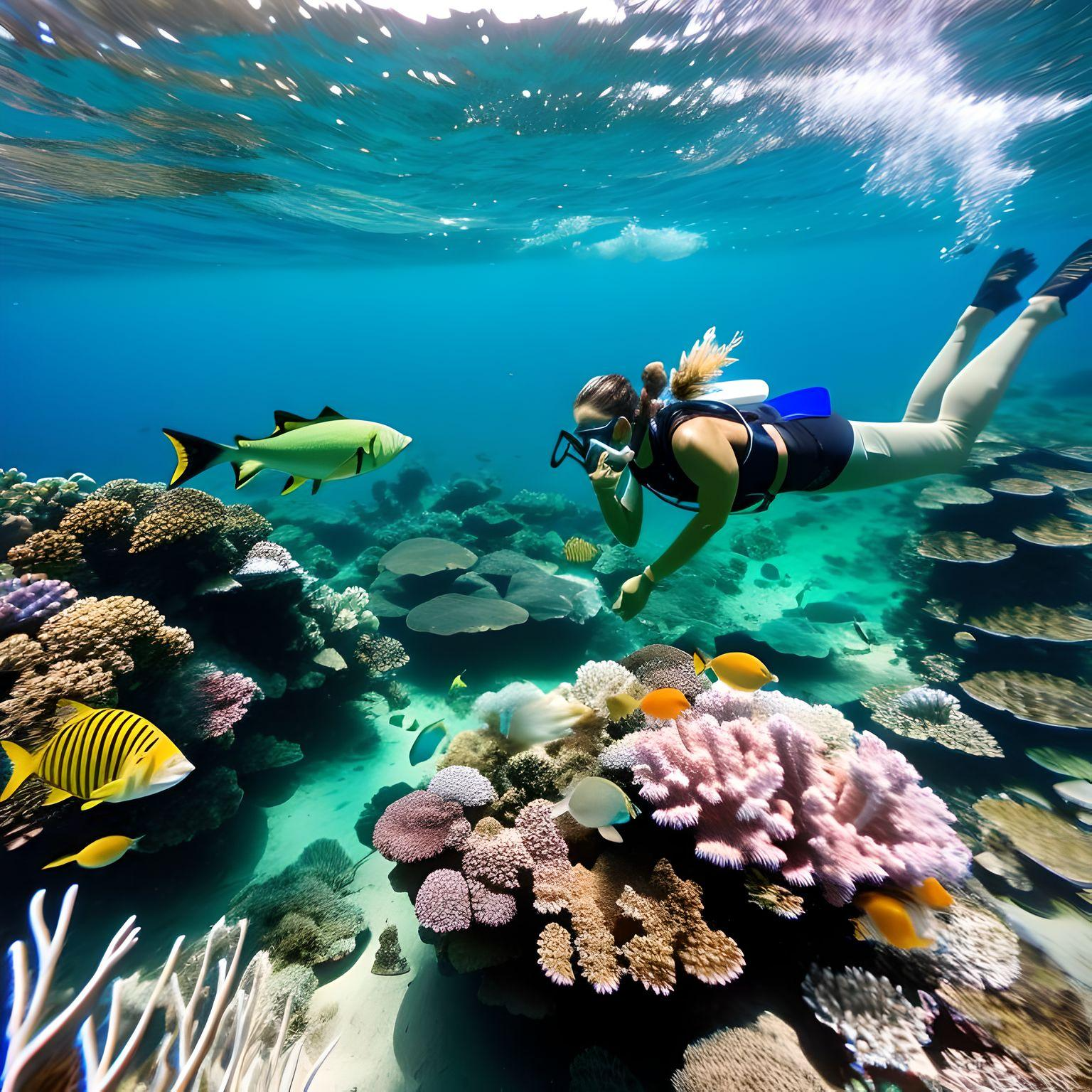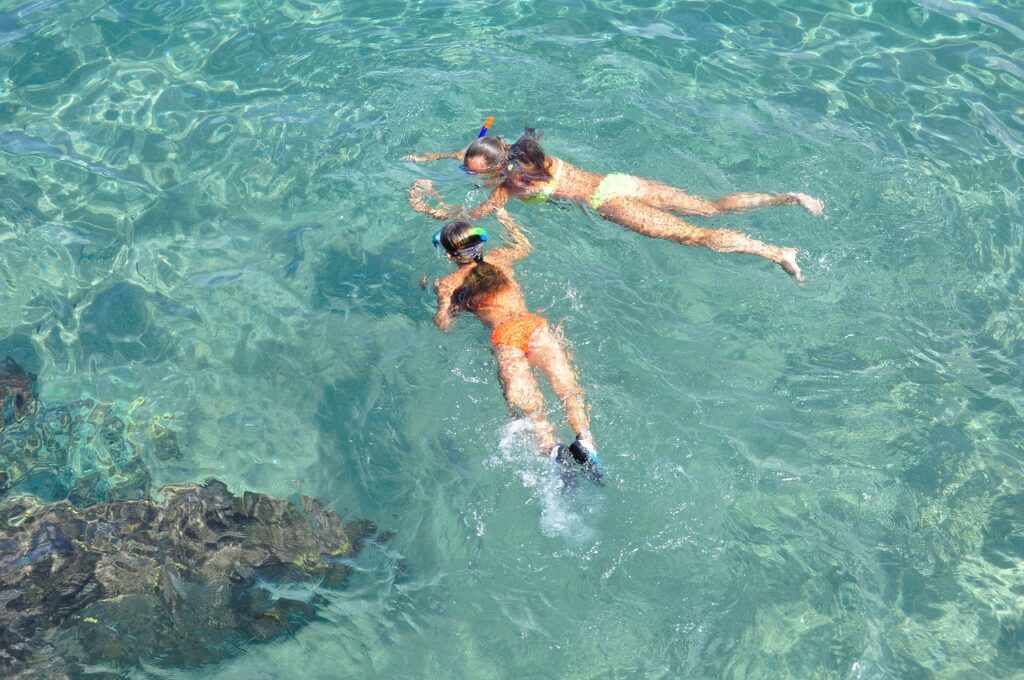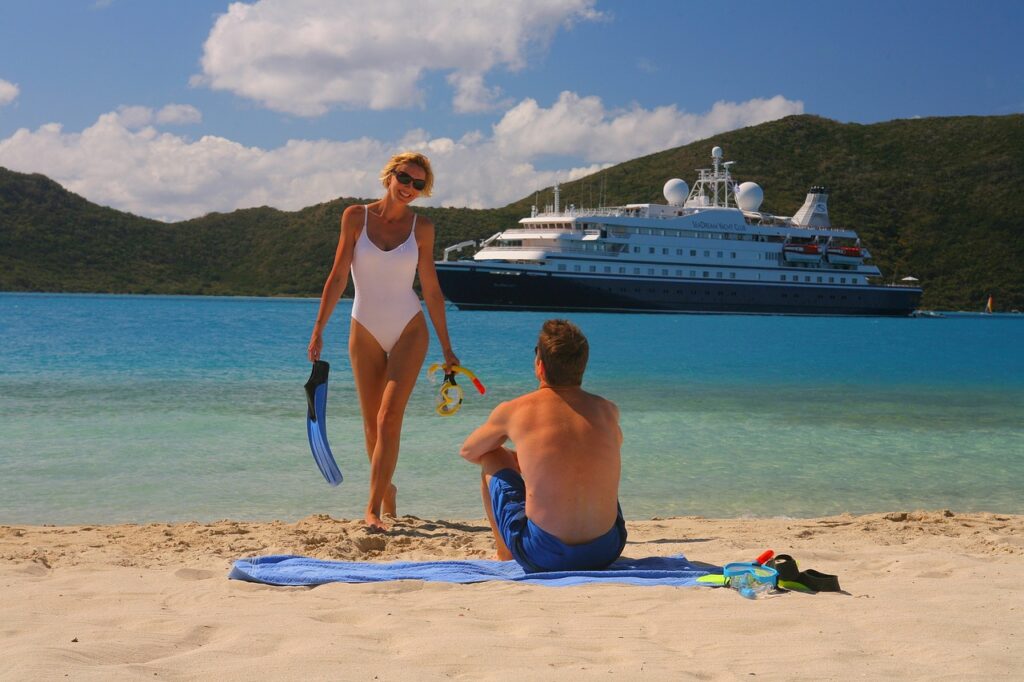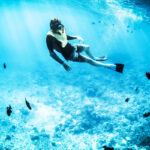So you’ve heard about snorkeling and you’re curious to know what it’s all about? Well, let me give you a quick rundown. Snorkeling is a popular recreational activity that allows you to explore the underwater world without the need for extensive diving equipment. All you really need is a mask, a snorkel tube, and some fins. By simply floating on the surface of the water and breathing through the snorkel, you can observe the incredible marine life and vibrant coral reefs below. It’s like having a front-row seat to a breathtaking world beneath the waves!

What is Snorkeling?
Definition
Snorkeling is an enjoyable water activity that allows you to explore the underwater world without the need for complicated diving equipment. It involves swimming on the surface of the water while wearing a mask and snorkel, which allows you to breathe through a tube that extends above the waterline. Snorkeling offers a unique opportunity to observe marine life and beautiful coral reefs, providing a glimpse into a whole new world beneath the surface.
Equipment
To go snorkeling, you will need a few essential pieces of equipment. The most important item is a mask, which covers your eyes and nose, creating an airtight seal. This allows you to see clearly underwater while keeping water out. You will also require a snorkel, a tube-shaped device that extends above the water, enabling you to breathe without coming up for air. Some snorkels have a built-in purge valve, which allows for easy clearing of any water that enters the tube. Additionally, fins are often worn to help you swim more efficiently and conserve energy. These pieces of equipment come in a variety of sizes and styles, so it’s important to choose ones that fit well and are comfortable.
Benefits
Snorkeling offers a range of benefits for both your physical and mental well-being. Firstly, it provides a great cardiovascular workout as swimming engages multiple muscle groups, improving strength and endurance. It also improves your lung capacity as you learn to control your breath while utilizing the snorkel. Moreover, snorkeling helps reduce stress and anxiety, allowing you to relax and unwind while exploring the underwater world. The beauty of the marine life and the sense of tranquility beneath the waves can be extremely rejuvenating. Snorkeling also acts as a means for connecting with nature, fostering a deeper appreciation and understanding of marine ecosystems and the importance of conservation.
Popular Locations
Snorkeling can be enjoyed in many breathtaking locations around the world, each offering unique underwater experiences. Some of the most popular snorkeling destinations include:
- The Great Barrier Reef, Australia: Known as the largest coral reef system in the world, the Great Barrier Reef offers an abundance of marine life and stunning coral formations.
- The Maldives: With its crystal-clear waters and vibrant coral reefs, the Maldives is a snorkeler’s paradise, offering the chance to spot colorful fish, sea turtles, and even manta rays.
- Hawaii, USA: With its warm waters and diverse marine life, Hawaii is a favorite destination for snorkelers. The Molokini Crater and Hanauma Bay are particularly renowned for their rich biodiversity.
- Bali, Indonesia: Bali boasts clear waters teeming with a vast array of marine life. Snorkelers can explore the USS Liberty shipwreck or encounter stunning coral reefs in locations such as Amed and Nusa Penida.
- The Red Sea, Egypt: The Red Sea is famous for its vibrant coral reefs and an abundance of exotic fish species. Destinations like Sharm El Sheikh and Dahab offer incredible snorkeling opportunities.
How Does Snorkeling Work?
Breathing Technique
One of the most crucial aspects of snorkeling is mastering the breathing technique. When using a snorkel, it’s important to breathe slowly and deeply through your mouth, allowing the tube to supply a steady flow of fresh air. Remember to exhale gently and fully to ensure an efficient exchange of oxygen and carbon dioxide. Take the time to practice this breathing method before starting your snorkeling adventure, as it may feel different compared to regular breathing.
Body Positioning
Achieving the correct body positioning is another key factor in successful snorkeling. Lie flat on the water’s surface with your body extended and your legs slightly apart. Keep your head facedown in the water, allowing the snorkel to stay above the surface. Use small kicks from your fins to maintain a steady pace and move effortlessly through the water. It’s important to relax your body and maintain a horizontal position to minimize drag and conserve energy.
Underwater Visibility
To fully appreciate the beauty of the underwater world while snorkeling, it’s essential to ensure optimal visibility. Before entering the water, make sure your mask is properly fitted and adjusted to create a tight seal around your face. Once in the water, avoid touching the inside of the mask, as it can cause fogging. To prevent fogging, you can use an anti-fog solution or saliva, rubbing it onto the inside lens and rinsing it off before use. Regularly clearing any water that enters the snorkel is also important to maintain clear visibility.
Safety Measures
Snorkeling can be a safe and enjoyable activity if proper safety measures are followed. It’s important to always snorkel with a buddy or in a group, as they can assist in case of an emergency. Start off in calm, shallow waters and gradually progress to deeper areas as you gain experience and confidence. Familiarize yourself with the location’s safety guidelines, such as the presence of dangerous marine life or strong currents, and adhere to them accordingly. Additionally, always wear a buoyancy device, such as a life vest, to ensure you stay afloat in case of fatigue or unexpected circumstances.
Snorkeling Tips and Tricks
Choosing the Right Equipment
Choosing the right equipment is essential for a comfortable and enjoyable snorkeling experience. When selecting a mask, consider factors such as fit, comfort, and peripheral vision. Try on different sizes and models to find the one that fits your face shape best. Similarly, when picking fins, opt for ones that are snug but not too tight, allowing for efficient propulsion through the water. Test the snorkel by breathing through it to ensure it’s comfortable and provides an optimal flow of air. Renting equipment from a reputable snorkel shop is also a cost-effective option if you don’t snorkel frequently.
Equalizing Ear Pressure
Equalizing ear pressure is essential when snorkeling, especially if you plan to dive down a few feet. To equalize, pinch your nose with your fingers and gently blow while keeping your mouth closed. This action helps to equalize the pressure in your ears, preventing discomfort or potential ear damage. It’s important to equalize regularly during your descent and ascent, as water pressure changes with depth.
Dealing with Foggy Masks
A common issue while snorkeling is a foggy mask, which can obstruct your vision and hinder your overall experience. To prevent fogging, apply a small amount of toothpaste or an anti-fog solution specifically designed for masks to the inside surface of the lens. Rub it around, ensuring full coverage. Rinse the mask with clean water before use, and make sure it’s fully dry. This technique creates a thin protective film on the lens, preventing fog from forming. Alternatively, you can use a small amount of saliva on the inside lens and rinse it off before wearing the mask.
Navigating Underwater
While snorkeling, it’s important to be aware of your surroundings and navigate with caution to avoid collisions with other snorkelers or marine life. Take your time to observe the direction of currents or waves and adjust your path accordingly. Use your legs and fins to kick gently, allowing you to maneuver smoothly underwater. Practice turning your body without disturbing the water too much to maintain good visibility and prevent startling underwater creatures.
Conserving Energy
To maximize your time in the water and extend the duration of your snorkeling session, it’s essential to conserve energy. Focus on slow, relaxed movements and use your fins for propulsion rather than relying solely on your arms. Use long, slow kicks and maintain a steady, rhythmic breathing pattern to avoid overexertion. Take breaks when needed and float on the surface to rest. Remember, snorkeling is meant to be an enjoyable activity, so don’t push yourself beyond your comfort zone.
Common Snorkeling Mistakes to Avoid
Holding Breath
One common mistake made by beginner snorkelers is holding their breath while swimming underwater. Snorkeling is designed for continuous breathing through the snorkel tube, so holding your breath can lead to discomfort and potential complications. It’s important to relax and breathe normally through your mouth while keeping the snorkel above the water surface. This will ensure a steady flow of fresh air and a more enjoyable snorkeling experience.
Touching or Damaging Coral
When snorkeling, it’s crucial to respect the delicate ecosystem of the underwater environment. Avoid touching or stepping on coral, as it can cause irreparable damage. Coral is a living organism that takes years to grow and is home to countless marine creatures. Even a gentle touch can disrupt its growth and disrupt the entire ecosystem. Remember to admire coral from a distance and be mindful of your surroundings to avoid accidental contact.
Disturbing Marine Life
One of the joys of snorkeling is encountering various marine creatures in their natural habitat. However, it’s important to observe them from a respectful distance and refrain from touching or chasing them. Snorkelers should avoid trying to ride turtles or grab onto fish, as this can cause stress for the animals and may harm them. Take the time to appreciate their beauty and observe their natural behavior without interfering.
Venturing Too Far
Always be aware of your limits and avoid venturing too far from the shore or your boat while snorkeling. Strong currents or unexpected weather changes can make it challenging to swim back, potentially putting you at risk. Stick to designated snorkeling areas and respect any warning signs or instructions provided by lifeguards or tour operators. Snorkeling closer to the shore also allows for easier communication with others and quicker assistance if needed.
Ignoring Safety Instructions
Whether you’re snorkeling independently or as part of a guided tour, it’s important to pay attention to any safety instructions provided. This includes information about potential hazards, emergency procedures, and any specific guidelines related to the area you’re snorkeling in. Ignoring these instructions can put your safety and the safety of others at risk. Stay informed and follow the guidelines to ensure a safe and enjoyable snorkeling experience.

This image is property of pixabay.com.
Snorkeling Dangers and Precautions
Sunburn and Heat Exhaustion
Spending extended periods in the sun while snorkeling can lead to sunburn and heat exhaustion. To protect yourself, apply a waterproof sunscreen with a high SPF before entering the water, and reapply as needed. Wear protective clothing, such as rash guards or wetsuits, to shield your skin from harmful UV rays. Additionally, stay hydrated by drinking plenty of water throughout your snorkeling session and take breaks in shaded areas to avoid overheating.
Hypothermia and Cold Water
Snorkeling in cold water can lead to hypothermia if you’re not properly prepared. Coldwater temperatures can cause a rapid loss of body heat, leading to fatigue and potentially life-threatening situations. To prevent this, wear a wetsuit or a snorkeling vest that provides thermal protection. These garments trap a thin layer of water against your skin, which is warmed by your body, acting as insulation. It’s also important to monitor your body’s response to the cold, and if you start shivering or feeling excessively cold, exit the water and warm up immediately.
Drowning Risks
While snorkeling, there is a potential risk of drowning, especially if you’re not a strong swimmer or if unexpected circumstances arise. It’s essential to always snorkel with a buddy or in a group, as they can provide assistance if needed. Choose calm waters and avoid areas with strong currents or big waves. If you encounter difficulties, don’t panic. Lift your head above the water, signal for help, or use your safety whistle if you have one. It’s also important to regularly check your snorkel for any water intake, as accidental inhalation can lead to choking.
Jellyfish and Sea Creatures
Encountering marine life, such as jellyfish, can be a potential danger while snorkeling. Some jellyfish have stingers that can cause painful stings or allergic reactions. It’s important to be aware of the presence of jellyfish and follow any instructions or warnings provided by local authorities. Wearing a protective rash guard or wetsuit can minimize the risk of jellyfish stings. Similarly, always give sea creatures their space and avoid touching or provoking them, as some species can be venomous or protective of their territory.
Strong Currents and Riptides
Snorkeling in areas with strong currents or riptides can be extremely dangerous, especially for inexperienced swimmers. These currents can quickly sweep you away from your intended location, making it challenging to swim back to safety. Before entering the water, take note of any warning signs or instructions regarding strong currents. If caught in a strong current, try to swim parallel to the shore until you’re out of its pull, then swim back to the shore diagonally. If you’re unsure about the conditions, it’s best to seek advice from lifeguards or experienced snorkelers before entering the water.
Exploring Snorkeling Gear
Mask and Snorkel
The mask is one of the most essential pieces of snorkeling gear as it allows you to see clearly underwater. When choosing a mask, opt for one that fits comfortably and creates a watertight seal around your face. Consider features such as a wide field of vision, a tempered glass lens for durability, and a strap that allows for easy adjustment. The snorkel, on the other hand, should be comfortable to use and provide optimal airflow. Look for a snorkel with a purge valve, which makes it easier to expel any water that enters the tube.
Fins
Fins, also known as flippers, play a crucial role in snorkeling by improving propulsion and maneuverability in the water. When selecting fins, you want to ensure they fit snugly but are not too tight or uncomfortable. Fins come in various styles, including full-foot fins that are worn barefoot or open-heel fins that require booties for added comfort. Consider the blade design, material, and length of the fins to find the ones that best suit your swimming style and snorkeling needs.
Buoyancy Devices
Buoyancy devices, such as snorkeling vests or life vests, are important for enhancing safety and providing additional flotation support. Snorkeling vests can be inflated and deflated to adjust buoyancy levels, making them more versatile for different swimming conditions and skill levels. Life vests are inherently buoyant and can be worn by individuals who may not be confident swimmers. These devices not only provide reassurance in the water but also help conserve energy by reducing the effort needed to stay afloat.
Wetsuits and Snorkeling Vests
Wetsuits and snorkeling vests are essential in colder water or when snorkeling for extended periods. Wetsuits provide insulation by trapping a thin layer of water against your skin, which is heated by your body, creating a warming effect. They come in varying thicknesses, ranging from thin suits for tropical waters to thicker suits for colder climates. Snorkeling vests, on the other hand, are lightweight and provide some thermal protection. They are often inflatable, allowing you to adjust buoyancy and stay warm in cooler waters.
Accessories and Extras
Several accessories can enhance your snorkeling experience and make your time in the water more enjoyable. To prevent blisters and chafing, consider wearing neoprene socks or booties. A snorkel keeper can help keep your snorkel attached securely to your mask strap, preventing it from slipping off. Underwater cameras or waterproof phone cases allow you to capture and document your underwater adventures. Additionally, a dive flag or signal device is crucial for visibility and communication with others in the water, especially in busy snorkeling areas.

This image is property of pixabay.com.
Benefits of Snorkeling
Physical Health Benefits
Snorkeling offers a range of physical health benefits. The activity engages multiple muscle groups, including the core, arms, legs, and back. The resistance provided by the water improves strength, endurance, and cardiovascular fitness. Snorkeling also promotes flexibility, as the gentle movements required for swimming and diving help to stretch and elongate muscles. The buoyancy of the water reduces the impact on joints, making it an ideal exercise for individuals with joint issues or injuries.
Mental and Emotional Well-being
In addition to physical health benefits, snorkeling has a positive impact on mental and emotional well-being. Being in and around water has been found to promote relaxation and reduce stress. The soothing sounds of the ocean, the gentle rocking motion of the waves, and the mesmerizing beauty of the underwater world contribute to a sense of calm and tranquility. Snorkeling allows you to disconnect from the stresses of daily life and immerse yourself in the present moment, promoting mindfulness and mental clarity.
Connection with Nature
Snorkeling offers a unique opportunity to connect with the natural world and gain a deeper appreciation for marine ecosystems. Observing the vibrant colors of coral reefs, swimming alongside schools of fish, and encountering curious sea turtles can be awe-inspiring experiences. Snorkeling fosters a sense of curiosity, wonder, and respect for the intricate balance of marine life. It promotes environmental awareness and encourages individuals to become advocates for ocean conservation and the protection of fragile ecosystems.
Accessible to All Ages and Skill Levels
One of the greatest advantages of snorkeling is its accessibility. It is an activity that can be enjoyed by people of all ages and swimming abilities. Even non-swimmers can participate by wearing a life vest or snorkeling in shallow, calm waters. Snorkeling is a great family activity, allowing parents to introduce their children to the wonders of the ocean. It also provides an opportunity for elderly individuals or those with limited mobility to experience the beauty of underwater environments with the assistance of flotation devices and support from their peers.
Snorkeling vs. Scuba Diving
Depth and Time Limitations
Snorkeling and scuba diving differ in terms of depth and time limitations. Snorkeling is limited to the surface of the water, allowing you to observe the underwater world from above. It is ideal for exploring shallow reefs, observing marine life near the surface, and enjoying shorter durations in the water. On the other hand, scuba diving allows for greater depths and longer durations underwater. With scuba diving, you can explore deeper reef systems, wrecks, and encounter marine life at various depths.
Equipment and Training
Snorkeling requires minimal equipment compared to scuba diving. With snorkeling, you only need a mask, snorkel, and fins. Scuba diving, on the other hand, involves a more extensive list of equipment, including a dive regulator, buoyancy control device (BCD), dive computer, and tank. Scuba diving also requires specialized training and certification to ensure safety and competency. While snorkeling can be enjoyed by beginners without formal training, scuba diving requires proper education and certification to dive independently.
Cost Differences
When it comes to cost, snorkeling is generally more affordable than scuba diving. Snorkeling gear is relatively inexpensive and can be rented or purchased at reasonable prices. On the other hand, scuba diving equipment is more costly, and divers may need to invest in their own set of gear. Additionally, scuba diving requires certification, which often involves additional costs for training courses and certification fees. Snorkeling can be enjoyed without the need for these extra expenses, making it a more budget-friendly option.
Experience and Exploration
While both snorkeling and scuba diving provide unique underwater experiences, scuba diving offers a more immersive and extensive exploration of the underwater world. With scuba diving, you can venture deeper into the ocean, explore intricate coral formations, and encounter elusive marine creatures. Snorkeling, however, offers a simpler and more relaxed experience, allowing you to appreciate the beauty of the surface-level marine life. Both activities have their own merits and can be enjoyed based on personal preferences, comfort levels, and desired levels of adventure.
Environmental Impact of Snorkeling
Coral Reef Conservation
Snorkelers can play a significant role in coral reef conservation by following responsible snorkeling practices. Avoid touching or standing on coral, as this can cause irreparable damage. Use proper buoyancy control techniques to prevent accidental contact. Choose reef-safe sunscreens that are free from harmful chemicals that can bleach or damage coral. Participate in organized beach or underwater cleanups to help remove debris and promote a healthier marine environment. By being mindful of our impact and taking simple actions, we can contribute to the long-term preservation of coral reefs.
Responsible Snorkeling Practices
Responsible snorkeling practices involve respecting the marine environment and the creatures that inhabit it. Avoid chasing or harassing marine life, as this can cause stress and disrupt their natural behaviors. Take care not to drop litter in the water or leave any trash behind on the beach. Snorkelers should be mindful of their movements, minimizing contact with any underwater structures or fragile organisms. By practicing responsible snorkeling, we can minimize our impact on marine ecosystems and help protect the delicate balance of underwater life.
Reef-safe Sunscreens
Sunscreens play an important role in protecting our skin from harmful UV rays, but certain chemicals found in many sunscreens can be harmful to coral reefs and marine life. Ingredients such as oxybenzone and octinoxate can contribute to coral bleaching and disrupt the growth and reproduction of coral. When snorkeling, opt for reef-safe sunscreens that are formulated to minimize environmental impact. These sunscreens use alternative UV filters that are less harmful to the aquatic ecosystem, allowing you to protect your skin while preserving the health of coral reefs.
Marine Life Protection
Part of snorkeling’s appeal is encountering and observing marine life in their natural habitat. To protect these creatures, it’s important to maintain a respectful distance and refrain from touching or grabbing them. Avoid disturbing their habitats, and take care not to remove any marine life or collect shells, as this disrupts the balance of fragile ecosystems. By appreciating marine life from a distance and respecting their space, we can ensure their continued well-being and contribute to the long-term preservation of underwater biodiversity.
Conclusion
Snorkeling is a captivating activity that allows you to explore the underwater realm and connect with the beauty of marine life. With the right equipment, proper techniques, and adherence to safety guidelines, snorkeling can provide a safe and enjoyable experience for individuals of all ages and skill levels. From the physical health benefits to the mental and emotional well-being it promotes, snorkeling offers a range of advantages. By understanding the environmental impact of snorkeling and adopting responsible snorkeling practices, we can help protect and preserve the delicate ecosystems that make snorkeling such a remarkable experience. So grab your mask, snorkel, and fins, and embark on an adventure beneath the waves to discover the wonders of the underwater world.




